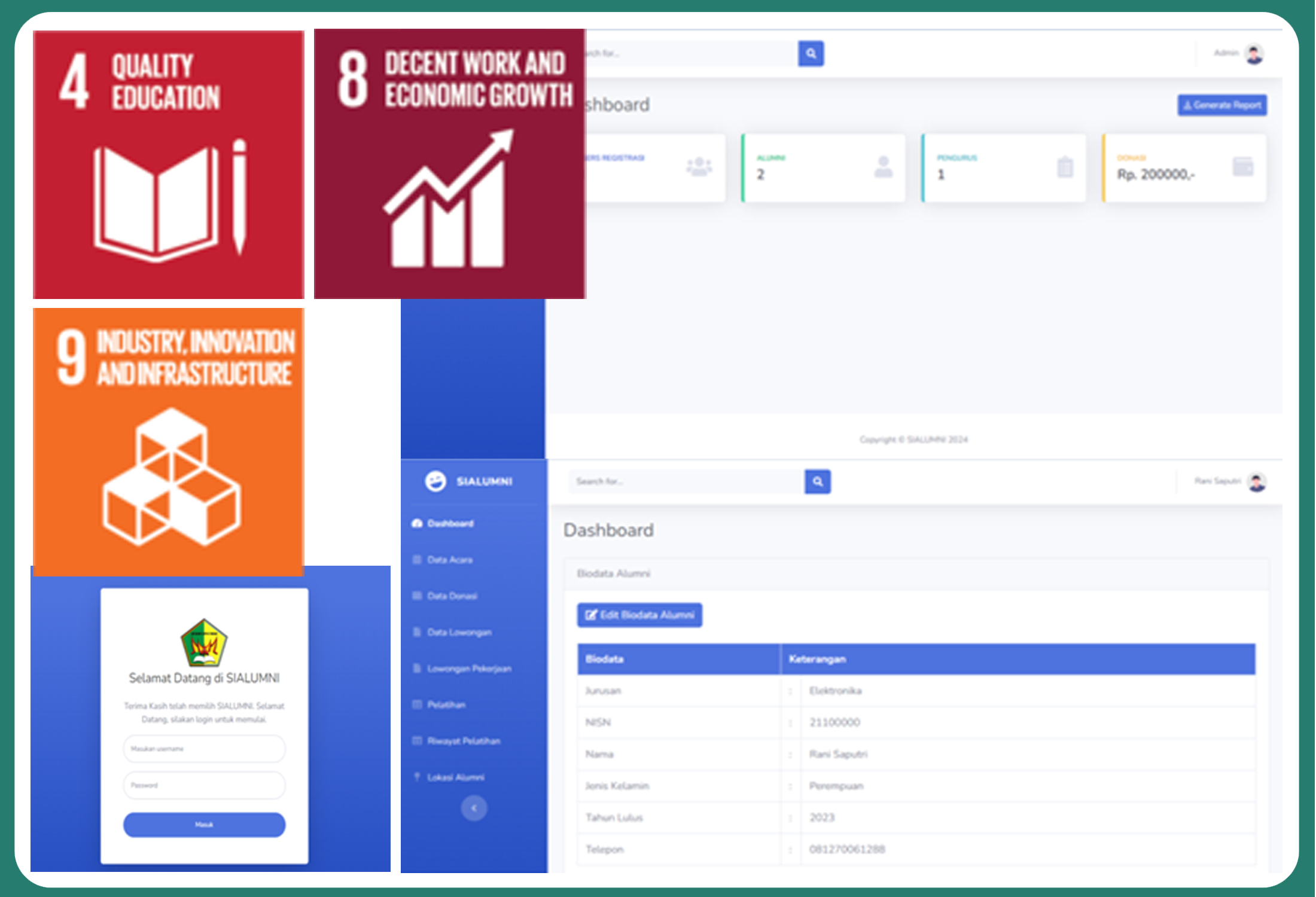Addressing Alumni Data Challenges in Vocational Education Through Web-Based Information System Development
DOI:
https://doi.org/10.24036/javit.v5i2.245Keywords:
Alumni Information System, Web-Based Application, Vocational Education, Role-Based Access Control, Educational TechnologyAbstract
The lack of centralized and accurate alumni data management systems remains a challenge for many vocational schools. This study aims to develop a web-based alumni information system for SMK Negeri 1 Koto XI Tarusan to streamline alumni data processing and improve post-graduation engagement. Using the Waterfall development model, the system was designed through sequential stages including requirement analysis, system design, implementation, testing, and maintenance. The result is a role-based information system that includes separate dashboards for administrators, alumni, and alumni coordinators. The system allows secure login, data editing, event announcements, and alumni networking. The implementation demonstrates that a structured development model can effectively address institutional data management needs and enhance user interaction. However, future improvements are needed to support mobile access, analytics integration, and broader deployment across institutions. This system serves as a foundational step toward digital transformation in alumni management for vocational education institutions.
Downloads
References
Y. Zhao, M. Zhao, and F. Shi, “Integrating Moral Education and Educational Information Technology: A Strategic Approach to Enhance Rural Teacher Training in Universities,” J. Knowl. Econ., vol. 15, no. 3, pp. 15053–15093, Dec. 2023, https://doi.org/10.1007/s13132-023-01693-z.
M. Alenezi, “Digital Learning and Digital Institution in Higher Education,” Educ. Sci., vol. 13, no. 1, p. 88, Jan. 2023, https://doi.org/10.3390/educsci13010088.
M. Ibrahim, N. Khairudin, and D. Salleh, “Enhancing interactive environment with applied of scenario based approach via EDpuzzle adoption,” AIP Conf. Proc., vol. 2608, no. 1, Jun. 2023, https://doi.org/10.1063/5.0145367.
T. ALKursheh, “Higher Tertiary Education Perspectives: Evaluating the Electronic Assessment Techniques of the Blackboard Platform for Fairness and Reliability,” Innoeduca. Int. J. Technol. Educ. Innov., vol. 10, no. 1, pp. 144–165, Jun. 2024, https://doi.org/10.24310/ijtei.101.2024.17813.
Yoto, A. Suyetno, A. P. Wibawa, Paryono, and A. Romadin, “Unveiling the Distinctive Impact of Vocational Schools Link and Match Collaboration with Industries for Holistic Workforce Readiness,” Open Educ. Stud., vol. 6, no. 1, Jan. 2024, https://doi.org/10.1515/edu-2024-0045.
R. Malhotra, M. Massoudi, and R. Jindal, “An alumni-based collaborative model to strengthen academia and industry partnership: The current challenges and strengths,” Educ. Inf. Technol., vol. 28, no. 2, pp. 2263–2289, Feb. 2023, https://doi.org/10.1007/s10639-022-11276-1.
C. Gupta and V. Gupta, “C4 Skills in the Engineering Graduate: A Study to Align Software Engineering Education with Market-Driven Software Industry Needs,” IEEE Trans. Educ., vol. 67, no. 1, pp. 31–43, Feb. 2024, https://doi.org/10.1109/TE.2023.3301625.
M. K. Budiarto, Asrowi, Gunarhadi, R. Karsidi, and A. Rahman, “E-Learning Platform for Enhancing 21st Century Skills for Vocational School Students: A Systematic Literature Review,” Electron. J. e-Learning, vol. 22, no. 5, pp. 76–90, Jun. 2024, https://doi.org/10.34190/ejel.22.5.3417.
P. Veluvali and J. Surisetti, “Learning Management System for Greater Learner Engagement in Higher Education—A Review,” High. Educ. Futur., vol. 9, no. 1, pp. 107–121, Jan. 2022, https://doi.org/10.1177/23476311211049855.
S. M. Mthabela, “Exploring the role of Technical Vocational Education and Training college management in utilising Learning Management Systems.” University of the Free State, 2024. Accessed: Jul. 03, 2025. [Online]. Available: http://hdl.handle.net/11660/12925.
M. Liu and D. Yu, “Towards intelligent E-learning systems,” Educ. Inf. Technol., vol. 28, no. 7, pp. 7845–7876, Jul. 2023, https://doi.org/10.1007/S10639-022-11479-6.
E. S. Vorm and D. J. Y. Combs, “Integrating Transparency, Trust, and Acceptance: The Intelligent Systems Technology Acceptance Model (ISTAM),” Int. J. Hum. Comput. Interact., vol. 38, no. 18–20, pp. 1828–1845, Dec. 2022, https://doi.org/10.1080/10447318.2022.2070107.
S. M. Haveliwala, “Patrolling Optimization for Enhanced Security in Schools (POESS) A Bayesian Stackelberg Game Approach,” 2025.
F. Malik and N. Akbar, “The development of a web-based internship information sys-tem at DLHK-DIY using the waterfall method,” Matrix J. Manaj. Teknol. dan Inform., vol. 14, no. 2, pp. 84–97, Jul. 2024, https://doi.org/10.31940/MATRIX.V14I2.84-97.
I. Mouakher, F. Dhaou, and J. C. Attiogbé, “Event-Based Semantics of UML 2.X Concurrent Sequence Diagrams for Formal Verification,” J. Comput. Sci. Technol., vol. 37, no. 1, pp. 4–28, Feb. 2022, https://doi.org/10.1007/s11390-021-1673-5.
R. Caschetto, “An Integrated Web Platform for Remote Control and Monitoring of Diverse Embedded Devices: A Comprehensive Approach to Secure Communication and Efficient Data Management,” Apr. 2024.
S. Scholarship@western, L. Divya, K. Mr, and M. Mostafa, “Security and Integration in Business Intelligence Tools: A Security and Integration in Business Intelligence Tools: A Comprehensive Study Comprehensive Study,” 2024, Accessed: Jul. 03, 2025. [Online]. Available: https://ir.lib.uwo.ca/etd/10462.
T. Biselx, “Mobile App Development for Youth Association Management,” 2025, Accessed: Jul. 03, 2025. [Online]. Available: http://www.theseus.fi/handle/10024/886833.
S. Gopalakrishnan, M. Matta, and H. Cavusoglu, “The Dark Side of Technological Modularity: Opportunistic Information Hiding during Interorganizational System Adoption,” Inf. Syst. Res., vol. 33, no. 3, pp. 1072–1092, Apr. 2022, https://doi.org/10.1287/isre.2022.1100.
T. Tuunanen, M. Salo, and F. Li, “Modular Service Design of Information Technology-Enabled Services,” J. Serv. Res., vol. 26, no. 2, pp. 270–282, May 2023, https://doi.org/10.1177/10946705221082775.
T. Barua, ; Md, and A. Rahman, “A Systematic Literature Review of User-Centric Design in Digital Business Systems Enhancing Accessibility, Adoption, and Organizational Impact,” Am. J. Sch. Res. Innov., vol. 2, no. 02, pp. 193–216, Apr. 2023, https://doi.org/10.63125/36W7FN47.
A. Mirabdolah, M. Alaeifard, and A. Marandi, “User-Centered Design in HCl: Enhancing Usability and Interaction in Complex Systems,” Int. J. Adv. Hum. Comput. Interact., vol. 1, no. 1, pp. 16–33, Dec. 2023, Accessed: Jul. 03, 2025. [Online]. Available: https://www.ijahci.com/index.php/ijahci/article/view/16.
F. H. M. Asri, D. Singh, Z. Mansor, and H. Norman, “A Review of Cross-Cultural Design to Improve User Engagement for Learning Management System,” KSII Trans. Internet Inf. Syst., vol. 18, no. 2, pp. 397–419, Feb. 2024, https://doi.org/10.3837/tiis.2024.02.007.
S. Tongsubanan and K. Kasemsarn, “Developing a Design Guideline for a User-Friendly Home Energy-Saving Application That Aligns with User-Centered Design (UCD) Principles,” Int. J. Hum. Comput. Interact., 2024, https://doi.org/10.1080/10447318.2024.2398324.
L. Mo and Y. Zhu, “How Is Alumni Giving Affected by Satisfactory Campus Experience? Analysis of an Industry-Research-Oriented University in China,” Sustain., vol. 14, no. 13, p. 7570, Jun. 2022, https://doi.org/10.3390/su14137570.
N. Nisar, A. Raza, P. N. Pathan, M. M. Sattar, and U. Memon, “Alumni-driven sustainability strategies: paving a way forward for sustainable development of public HEIs,” J. Appl. Res. High. Educ., vol. ahead-of-print, no. ahead-of-print, 2024, https://doi.org/10.1108/JARHE-03-2024-0140.
A. E. Maulana, P. G. Patterson, A. Satria, and I. A. Pradipta, “Alumni connectedness and its role in intention to contribute to higher education institutions,” J. Mark. High. Educ., Jul. 2023, https://doi.org/10.1080/08841241.2023.2186560.
D. Amani, “Internal branding and students’ behavioral intention to become active member of university alumni associations: the role of students’ sense of belonging in Tanzania,” Cogent Soc. Sci., vol. 8, no. 1, Dec. 2022, https://doi.org/10.1080/23311886.2021.1997171.
B. Francioni et al., “Does trust play a role when it comes to donations? A comparison of Italian and US higher education institutions,” High. Educ., vol. 82, no. 1, pp. 85–105, Jul. 2021, https://doi.org/10.1007/s10734-020-00623-1.
A. Baroncelli, D. Bolzani, and M. Landoni, “Mapping the engagement of alumni organisations in entrepreneurship education and support at UK universities,” Int. J. Manag. Educ., vol. 20, no. 2, p. 100648, Jul. 2022, https://doi.org/10.1016/j.ijme.2022.100648.

Downloads
Published
How to Cite
Issue
Section
License
Copyright (c) 2025 Melda Triyana Tanjung, Denny Kurniadi, Legiman Slamet, Ahmaddul Hadi

This work is licensed under a Creative Commons Attribution 4.0 International License.










